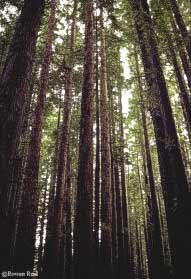|
|
|
Sawlogs
without pruning

Throughout most of Australia conventional
pine plantations focus on producing sawlogs with small branches
that are suitable for structural timber. Competition, rather
than manual pruning, is used to control the branch size. To
prevent competition slowing growth to a halt, or threatening
the forest’s stability or health, several thinning operations
are undertaken to reduce the basal area. Where possible, pulp
or other small diameter products are produced from the thinning
operation to help cover costs.
But farmers may put themselves at risk when they adopt these
regimes. If there isn’t a viable market for the thinnings
when thinning is required, the whole investment might be at
risk. Overstocked plantations under excessive competition are
susceptible to drought, diseases, insects and wind. Diameter
growth on the best trees can slow to a halt as the plantation
becomes locked up. In eucalypts, thinning in dense stands can
also lead to severe epicormic shoot development—that is,
shoots sprouting up the stem—as the trees try to rebuild
a canopy after a period of intense competition.
It is common for farmers to consider postponing the first thinning
until the trees are large enough to provide a commercial return.
However, experience suggests that farmers with small plantations
should be cautious about assuming they will be able to negotiate
a commercial thinning. To be viable the plantation must be relatively
large, easily accessible and close to markets. The machinery
required to efficiently harvest, delimb, debark and load small
diameter logs efficiently is expensive. Few farmers have access
to this equipment and—because of the small volume of timber
involved—many find themselves unable to attract contractors.
Cheap culling methods—for example, stem injection and ring
barking—offer a cheaper method of thinning to waste for
farmers who want to use competition to control branch development
in their plantations or native forests. These methods enable
farmers to maintain competition at a level required to encourage
self-pruning. They can then thin repeatedly to maintain diameter
growth.
Back to top
|
|
